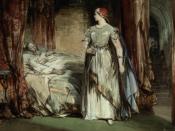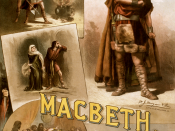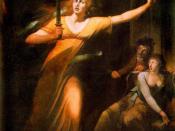In Shakespeare's Macbeth, major themes are shown through imagery. Recurring images such as sleep, blood, animals, light and darkness are used to conjure up vivid mental images in audience's imagination and to reveal the characters' emotions. The images also help in characterisation and make the reader more interested in the story. But just as importantly, these images are also used to show the audience the main themes of the play.
In Macbeth, light and darkness imagery show the theme, good verses evil and is used numerous times in the play. The audience can see that Macbeth becomes more evil as the play progresses. This change can also be seen through how he reacts to darkness. Before the murder of Duncan, Macbeth says, "Stars, hide your fires! Let not light see my black and deep desires" (Shakespeare, Macbeth 1.4.51-52). Later on in the novel, when he plans to kill Banquo and Fleance he welcomes the darkness so that the murder can take place: "Come seeling night, scarf up the tender eye of pitiful day" (3.2.46-47).
The growing evil in Macbeth can be seen through his acceptance of the darkness. There are also parts in the play when the witches who personify evil are described as being creatures of the night. Macbeth describes them as "secret, black, midnight hags" (4.1.47) and "instruments of darkness" (1.3.122). After the murder of Duncan, Ross and the Old Man talk about how the night "strangle[d] the travelling lamp" (2.4.7). Evil is prevailing over good after the death of Duncan. Later on in the play, when Macbeth asks Lady Macbeth what time it is, she replies that the night is "almost at odds with morning" (3.4.126). Both examples are ways that Shakespeare shows the conflict between good and evil. Darkness is linked with death as well. On...


